Sea Saba, Juliana’s Hotel, Saba, CaribbeanContents of this Issue: Sea Saba, Juliana’s Hotel, Saba, Caribbean Get Your Kicks from Textured Iridescent Surfaces? Give Me a Break The Trials and Tribulations of Dive Travel Bahamas’ Shark Mauls a Diver’s Arm in Chumming Area Curbing the Lionfish Invasion: A Futile Fight The Equipment Insurers Side of the Story Why Amazing Corals Spawn Simultaneously Gabe Watson Did Not Kill His Wife Editorial Office: Ben Davison Publisher and Editor Undercurrent 3020 Bridgeway, Suite 102 Sausalito, CA 94965 unexpected gems on King Kong’s island from the August, 2011 issue of Undercurrent
Dear Fellow Diver: My expectations were modest as I slowly descended on my first dive off Saba. We'd been briefed that, like other volcanic islands, Saba's underwater geology was primarily algae-covered volcanic rock. Coral would be scarce. Furthermore, this checkout dive at Babylon allowed Dick and Briar to assess us in an unchallenging environment. But frankly, the issue for me was more technical: Would my new Nikon D7000 in its Aquatica housing work as I hoped?
An unexpected new chapter on Saba began that night. My partner dined at Eden, where tables overlooked the lush outdoors which was lit by torches. My first surprise occurred when I asked what dark ales they served, expecting a Negra Modelo or some such. Instead, our waitress brought a bottle of Leffe Brune Dark Abbey from Belgium, a bittersweet, toffee-colored, malt brew from heaven. By night's end, we had split a wonderful grilled fish in a wine-based lobster sauce, a side of delightful sauerkraut mixed with grilled bacon and apple bits, and enjoyed more Leffe Brune. I was not shocked that the bill was about $110 with tip, considering what the food's transportation costs must have been.
Big, smiling ex-Londoner John Magor, co-owner of Sea Saba, met us on arrival. He packed us into a van for the winding trip up the only main road to Juliana's Hotel, nestled quaintly against the backdrop of cloud-covered Mt. Scenery in the little town of Windwardside. Its restaurant, pool and Jacuzzi overlooked the ocean. During the week, I came to appreciate the tasty breakfasts at its Tropics restaurant, and later its happy hours, a fun, happening local scene. After I settled into my modest but clean, air-conditioned, ocean-view room, John briefed my group on the routine. Our gear would remain on board, and the crew would tend it. A van would pick us up daily at 8:45 a.m. We'd make two dives and return in the early afternoon. We could dive our own profiles. Snorkeling was not worth exploring at the sites we'd dive. There were no beaches, so no shore diving. This was not going to be a 24-7 dive camp, like a Buddy Dive on Bonaire or CoCoView on Roatan. The afternoons and evenings were going to be topsideoriented, like it or lump it. (It is possible to arrange three tanks a day.) Our daily 20-minute drive to and from the harbor provided a mini-tour of the island. The red-tiled roofs and white walls of buildings reminded me of a European alpine village set in the Caribbean. The last quarter mile down steep, goat-populated switchbacks rivaling San Francisco's Lombard Street was always a hoot. Our boat, Giant Stride, was tied up about halfway down the 200-foot-long pier. It was a twin-screw 38-footer with ample shelter and safety gear, a flying bridge and small cabin with enclosed marine head. Although it was outfitted for 25 divers, we dove with about half that number. I exited off the stern platform, re-entering via a T-bar ladder. They gave a thorough briefing before each dive. Our non-Saban crew was primarily from the U.S. Our skipper, thirty-something Nick, was from Wisconsin. Dick, a world-class Ironman winner in his mid-70s, was from upstate New York; Lisa from North Carolina and Briar, a Kiwi, looked in their 20s. Tent Wall and Man O'War, the second pair of sites, were beautiful. At Tent Wall, I dove over and along a ledge that provided easy navigational clues. A wide-angle lens paid off, because much of what I was looking at seemed King Kongsized, from barrel sponges as big as garbage cans to purple gorgonians wide enough to hide behind. A nurse shark was resting on a ledge as I began the dive. Typical reef fish swam by: gray and French angelfish, four-eyed and banded butterflyfish, a dancing juvenile spotted drum, blue tang, parrotfish, coney, even a soapfish. A footlong Caribbean lobster faced off with another photographer in our group, caught in the open on a sandy bottom but unwilling to back down. This tableau was set against the backdrop of other volcanic island bottoms: Boulders and rubble painted with colorful dashes of yellow, red and purple, separated by stretches of sand without much hard-coral-encrusted reef. At Man O'War, I came across six tarpon which hung in the water column, hovering as I approached -- a brief moment of haunting beauty. On my third day, the weather required us to stick closer to lee shores. I contented myself with more experimentation with my new wide-angle zoom lens. With a 1.4 teleconverter, I was able to get some unexpected close-ups of a roving conch and a yellow-face pike blenny poking its head out of its sheltering tube. Thankfully, Saba's afternoon and evening topside highlights complemented my ration of diving. I trooped a block up the steep streets to the local town center. Far from being a sleepy little village, restaurants were bustling, and people were walking and talking as if on a scaled-down Rush Street in downtown Chicago. The corner grocery reminded me of the canteen at a large campground: lots of goodies and treats in the middle of nowhere. Most of the restaurants were so small that Sea Saba booked us ahead to ensure they would be open for business and could seat more than 10 people at a time. At Saba's Treasure, dining at a simple, checkerboard-painted table with plastic lawn chairs, the red snapper was tasty, and paired with a simple pizza and Caribe beer, it ran $50 for two. My ribeye with mushroom sauce at Tropics Café Wednesday's "Grill Night" was one of the best steaks I'd ever had. The Thursday night special prime-rib dinner at Brigadoon was outstanding, the Mackeson Triple XXX Milk Stout it served was incredible. Entertainment ranged from the intellectual to the slightly bawdy. Before dinner at the EcoLodge, biologist Tom van't Hof delivered a fast-paced, fact-filled slide presentation covering the ecosystems on Saba. Tom helped establish the Saba Marine Park, and was founder of the EcoLodge. Trish Chaamma, high-spirited co-owner of the Brigadoon, was decidedly more risqué. She decided, after dinner over a complementary special nightcap of her own concoction (rum, vanilla, ginger and cinnamon) that our group was mature enough to be treated to her line of adult humor -- one sex-laced joke after another. Early in the week, Becca from Sea Saba guided us through a slide presentation about Saba, its history and diving. A walk uphill to JoBean's glass bead shop provided a cultural education in itself. As our tour arranger, Sea Saba expertly suggested sundry diversions during the week, including hiking and guided sightseeing. On the fourth day, Lady Luck smiled: Both weather and Sea Saba were thumbs-up for a morning dive on Twilight Zone, one of Saba's famous pinnacles. I was in high spirits finning against the current to the mooring line. The group hung like pennants in a breeze. The current vanished as I dropped to 104 feet, where a nurse shark lounging on the bottom greeted me. I made my way around one of the twin pinnacles, then the other, the wide-angle lens well suited for capturing divers headed toward the peaks in the 100-foot visibility. I'd been on other seamounts on different islands, but always in visibility that made it difficult to appreciate and take in the entire formations from a distance. Here, I could take in the entire pinnacle, from bottom to top. The geology wasn't the only feature of interest. Large, colorful fans and corals created foregrounds for magazine-perfect "modeling opportunities." My time at depth was 37 minutes well spent. I surfaced feeling a calm but exhilarated dive afterglow. Back on board, talk was of the King of Qatar, who tipped a local divemaster $1,000 on a recent dive trip aboard Katara, the king's 400-plus-foot mega yacht -- for a single (canceled) dive. On our second dive, at Lou's Ladder, I experienced my second big buzz of the day when I hung out with another group of laid-back tarpon for more than 20 minutes. They were so unaffected by our presence, possibly due to the area's status as a protected marine park, that one of them literally rested against my head. One came so close that I could not resist reaching out to touch its muscular body. It didn't dart away, just casually distanced itself, but remained very close. There was a definite feeling of magic about the experience.
My last two dives of
the week were pleasant, condensed versions of our previous dives. Tedran Wall offered outcrops,
mini-pinnacles and more fantastic sponges,
fans, and soft coral of the sort that make
for great wide-angle photo opportunities you
see in magazines. On a sandy slope where
I spotted two white and blue tentacles of
an unusual segmented worm sticking out of
the sand, and definitely "not in the book"
(Humann and DeLoach's creature ID guide).
Saba is crisscrossed by well-marked hiking trails, most of them up and down the mountainside. My wife felt completely safe walking them alone. On our last day, I climbed Mount Scenery through four eco-zones, ending in cloud forest at the 2877-foot peak. Though enshrouded by clouds much of the time, the views of the airport and neighboring islands that day were stunning. That afternoon, we took a driving tour to Hell's Gate, passing a beautiful church, government buildings and the medical university, and stopping at many pretty overlooks. A previous afternoon's visit to the local museum helped explain why the island's geography made it inhospitable to settlement. The last morning included some sightseeing, as we hiked down to the tidal pools below the runway before the flight. Looking at the mountainside while taking off, I left with the pleasant thought that the unexpected gems I found on Saba made it worth following the road less traveled. --M.S.
|

I want to get all the stories! Tell me how I can become an Undercurrent Online Member and get online access to all the articles of Undercurrent as well as thousands of first hand reports on dive operations world-wide
| Home | Online Members Area | My Account |
Login
|
Join
|
| Travel Index |
Dive Resort & Liveaboard Reviews
|
Featured Reports
|
Recent
Issues
|
Back Issues
|
|
Dive Gear
Index
|
Health/Safety Index
|
Environment & Misc.
Index
|
Seasonal Planner
|
Blogs
|
Free Articles
|
Book Picks
|
News
|
|
Special Offers
|
RSS
|
FAQ
|
About Us
|
Contact Us
|
Links
|
3020 Bridgeway, Ste 102, Sausalito, Ca 94965
All rights reserved.

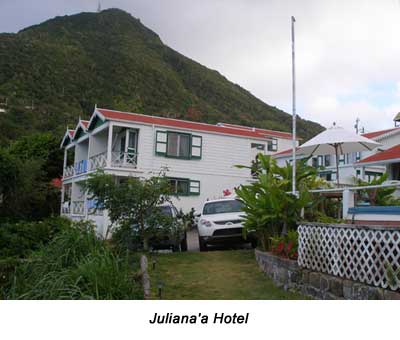 So I didn't care that the first fishes I saw and
snapped were a familiar yellow-tailed damsel, a little
blue chromis and a coney. The pressure to take perfect
pictures of rare fish was off. I stalked yellowhead jawfish
rising from their holes in the sand and shot banded
butterfly fish, blackbar soldierfish, redband parrotfish,
black durgon, blue tang, honeycomb cowfish, bar jack
-- all in the first 10 minutes. And I also experienced
the unexpected: a bubbling, golden, warm, sandy bottom
heated by Saba's somewhat dormant but active volcanic
foundations. My allpurpose
60mm macro
lens was fine for
the reef fish and
flamingo tongues,
but couldn't capture
the nurse shark
and large sponges.
I didn't need my
Sub-Sea 10x diopter.
Surfacing after
more than an hour
in the 81-degree
water, we went on
to our second dive,
where it was much
the same, yet my impressions were positive, in the manner
of a nice vanilla ice cream cone. Better
still, Sea Saba was true to its word
about letting experienced divers dive
their own profiles.
So I didn't care that the first fishes I saw and
snapped were a familiar yellow-tailed damsel, a little
blue chromis and a coney. The pressure to take perfect
pictures of rare fish was off. I stalked yellowhead jawfish
rising from their holes in the sand and shot banded
butterfly fish, blackbar soldierfish, redband parrotfish,
black durgon, blue tang, honeycomb cowfish, bar jack
-- all in the first 10 minutes. And I also experienced
the unexpected: a bubbling, golden, warm, sandy bottom
heated by Saba's somewhat dormant but active volcanic
foundations. My allpurpose
60mm macro
lens was fine for
the reef fish and
flamingo tongues,
but couldn't capture
the nurse shark
and large sponges.
I didn't need my
Sub-Sea 10x diopter.
Surfacing after
more than an hour
in the 81-degree
water, we went on
to our second dive,
where it was much
the same, yet my impressions were positive, in the manner
of a nice vanilla ice cream cone. Better
still, Sea Saba was true to its word
about letting experienced divers dive
their own profiles.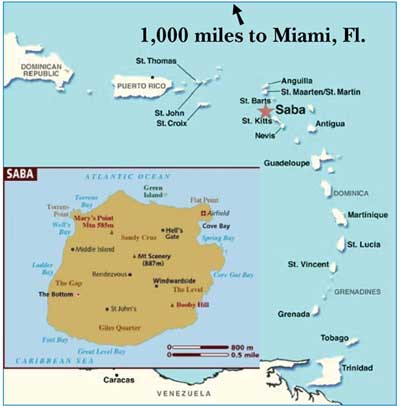 For years, I've relished the idea of going to Saba, population 2,000 --
inspired by images of a remote, mountainous, cloud-enshrouded home to the original
King Kong and a listing in the book, "1,000 Places to go Before You Die." My
local dive shop hosted this April trip, which from the Midwest took less than a
day. During the long layover in St. Maarten, I stood on the beach as landing passenger
jets passed only 100 feet or so directly overhead. The second bit of fun
was landing on Saba in a WinAir Twin Otter. The runway is less than 400 meters
long, bounded by sheer dropoffs into the sea at either end. Think landing on the
deck of an aircraft carrier moored alongside a mountain. You can find videos of
this on YouTube.
For years, I've relished the idea of going to Saba, population 2,000 --
inspired by images of a remote, mountainous, cloud-enshrouded home to the original
King Kong and a listing in the book, "1,000 Places to go Before You Die." My
local dive shop hosted this April trip, which from the Midwest took less than a
day. During the long layover in St. Maarten, I stood on the beach as landing passenger
jets passed only 100 feet or so directly overhead. The second bit of fun
was landing on Saba in a WinAir Twin Otter. The runway is less than 400 meters
long, bounded by sheer dropoffs into the sea at either end. Think landing on the
deck of an aircraft carrier moored alongside a mountain. You can find videos of
this on YouTube.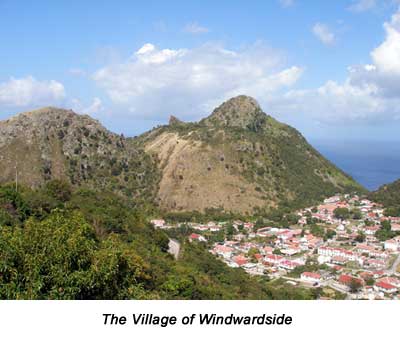 I was still keyed up from the earlier dives when I jumped in for our night
dive at Tent Wall's white buoy. This formation was easy to follow out and back
from the mooring. Giant basket stars unfolded their arms wide, and cardinalfish
played in the safety
of recesses in the reef's
folds. A black durgon hid in
another crevice, only showing
its pearly whites against the
beautiful spiraling pattern
of yellow and red diamonds
that surrounded its mouth,
"sleeping" in the manner of
a parrotfish. A sponge crab,
whose carapace may have measured
a foot across, backed
away from my lights. I almost
spit out my regulator when an
unabashed octopus came to rest
on another diver's head.
I was still keyed up from the earlier dives when I jumped in for our night
dive at Tent Wall's white buoy. This formation was easy to follow out and back
from the mooring. Giant basket stars unfolded their arms wide, and cardinalfish
played in the safety
of recesses in the reef's
folds. A black durgon hid in
another crevice, only showing
its pearly whites against the
beautiful spiraling pattern
of yellow and red diamonds
that surrounded its mouth,
"sleeping" in the manner of
a parrotfish. A sponge crab,
whose carapace may have measured
a foot across, backed
away from my lights. I almost
spit out my regulator when an
unabashed octopus came to rest
on another diver's head.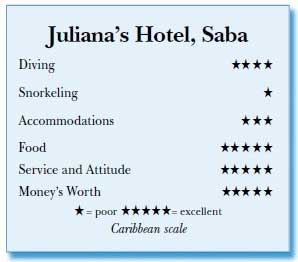 We hit Tent Wall Canyon for our last dive
of the week. Here, a shallow canyon some 45
feet deep passes between two 20-foot-high
walls covered in yellow, red, pink and green
sponges, hydroids and algae. Familiar reef
fish such as spotted trunkfish, a French
angelfish, stoplight parrotfish, French
and Caesar grunts, black bar soldierfish,
mahogany snapper, white spotted filefish,
coney, bluehead, red-lipped blenny and trumpetfish were there, though not in great
numbers. But there was another first for me: a very busy dark mantis shrimp, camouflaged
well against its backdrop. Toward the end of the dive, I admired the garden-
like quality of the yellow sea fans, brown soft coral, and yellow tube sponges
on the top, flat shelf of the wall near the mooring. I watched as the divemasters
peered intently at a brain coral. A pair of emblemariopsis blennies nestled into
adjacent parallel grooves of the coral. Anthropomorphizing, they actually looked,
well, happy.
We hit Tent Wall Canyon for our last dive
of the week. Here, a shallow canyon some 45
feet deep passes between two 20-foot-high
walls covered in yellow, red, pink and green
sponges, hydroids and algae. Familiar reef
fish such as spotted trunkfish, a French
angelfish, stoplight parrotfish, French
and Caesar grunts, black bar soldierfish,
mahogany snapper, white spotted filefish,
coney, bluehead, red-lipped blenny and trumpetfish were there, though not in great
numbers. But there was another first for me: a very busy dark mantis shrimp, camouflaged
well against its backdrop. Toward the end of the dive, I admired the garden-
like quality of the yellow sea fans, brown soft coral, and yellow tube sponges
on the top, flat shelf of the wall near the mooring. I watched as the divemasters
peered intently at a brain coral. A pair of emblemariopsis blennies nestled into
adjacent parallel grooves of the coral. Anthropomorphizing, they actually looked,
well, happy.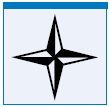 Diver's Compass: My seven-night stay with bundled airfare from the
Midwest, airport transfers, daily breakfast, two dinners, totaled
about $3,700 for a diver/non-diver package . . . there was a $36
Saba Marine Park fee, $60 for nitrox for the week, and a $75 add-on
for the night dive . . . we tipped our captain and dive master $5
each per tank . . . Sea Saba will handle all your on-island reservations
and itinerary . . . Contrary to the stated six-pound carryon
restriction, we were allowed as much weight as we wanted on the
WinAir flight to Saba, as long as it would fit into one carryon;
and they could care less about the duty-free booze we stocked up on in St. Maarten
(at very reasonable prices) . . . Saba is subject to hurricanes from June through
November, but only averages about 40 inches of rain annually . . . After climbing
Mount Scenery, get a free Certificate of Achievement at Saba's Tourist Bureau . .
. U.S. dollars and credit cards were generally accepted, but using cash will save
you the foreign transaction fees . . . AC current is same as in the U.S.. . ..
Web site: Sea Saba -
Diver's Compass: My seven-night stay with bundled airfare from the
Midwest, airport transfers, daily breakfast, two dinners, totaled
about $3,700 for a diver/non-diver package . . . there was a $36
Saba Marine Park fee, $60 for nitrox for the week, and a $75 add-on
for the night dive . . . we tipped our captain and dive master $5
each per tank . . . Sea Saba will handle all your on-island reservations
and itinerary . . . Contrary to the stated six-pound carryon
restriction, we were allowed as much weight as we wanted on the
WinAir flight to Saba, as long as it would fit into one carryon;
and they could care less about the duty-free booze we stocked up on in St. Maarten
(at very reasonable prices) . . . Saba is subject to hurricanes from June through
November, but only averages about 40 inches of rain annually . . . After climbing
Mount Scenery, get a free Certificate of Achievement at Saba's Tourist Bureau . .
. U.S. dollars and credit cards were generally accepted, but using cash will save
you the foreign transaction fees . . . AC current is same as in the U.S.. . ..
Web site: Sea Saba - 